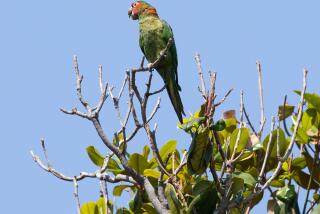On Midway Atoll, Some 1 Million Gooney Birds Really Do Rule
- Share via
MIDWAY ATOLL — No one seems to know exactly who came up with the name or when it first was used, but they all seem to agree that it fits: gooney.
As in gooney bird.
More precisely, the Laysan albatross--about 1 million of which call Midway Atoll home.
“I suppose that [terminology] was during the military days,” said Tim Bodeen, the national wildlife refuge manager at Midway. “I suppose they were kind of gooney.”
Like thousands of little statues, they dot every acre of the landscape and transport visitors smack into what seems like a scene from Alfred Hitchcock’s “The Birds.”
These birds don’t attack, but they don’t seem to want to budge--and they are quick to peck at a human’s feet.
Returning to Midway for the first time in almost two decades, Navy Rear Adm. Anthony L. Winns made sure to give the birds their due: “It’s good to see that the gooney birds are still in charge here.”
Consider: One of the most prominent statues on the island doesn’t pay homage to the pivotal Battle of Midway, which was fought offshore in June 1942 and proved to be the turning point in the Pacific during World War II.
It’s a statue of a gooney bird--a 20-foot tall depiction of an adult albatross situated in what once was one of the more high-traffic areas at this former Navy outpost.
Midway Atoll National Wildlife Refuge also is nesting ground for 14 other species of migratory seabirds and the endangered Hawaiian monk seal.
After more than two decades off the island, Richard Kelley remembers the birds. He was a weather officer for the Navy and lived on Midway’s Sand Island with his wife and two young sons from 1976-78.
Of his youngest son, who was about a year old: “He had really blond hair--tiny birds used to try and attack him to try and get nesting material.”
Kelley also remembers watching the gooneys learn to fly. Albatrosses return to land only to breed, spending their whole life flying over the ocean or on the water.
“When the gooneys were learning how to fly, the youngsters, a lot of them, would go out toward the beach and head into the wind and you could watch them stumble,” Kelley said. “They weren’t too successful the first couple times.
“When the adults would come back landing on land for the first time after a while, that would be interesting too.”
Adds Bodeen: “They’re just kind of a funny bird to watch.”
More to Read
Sign up for The Wild
We’ll help you find the best places to hike, bike and run, as well as the perfect silent spots for meditation and yoga.
You may occasionally receive promotional content from the Los Angeles Times.




